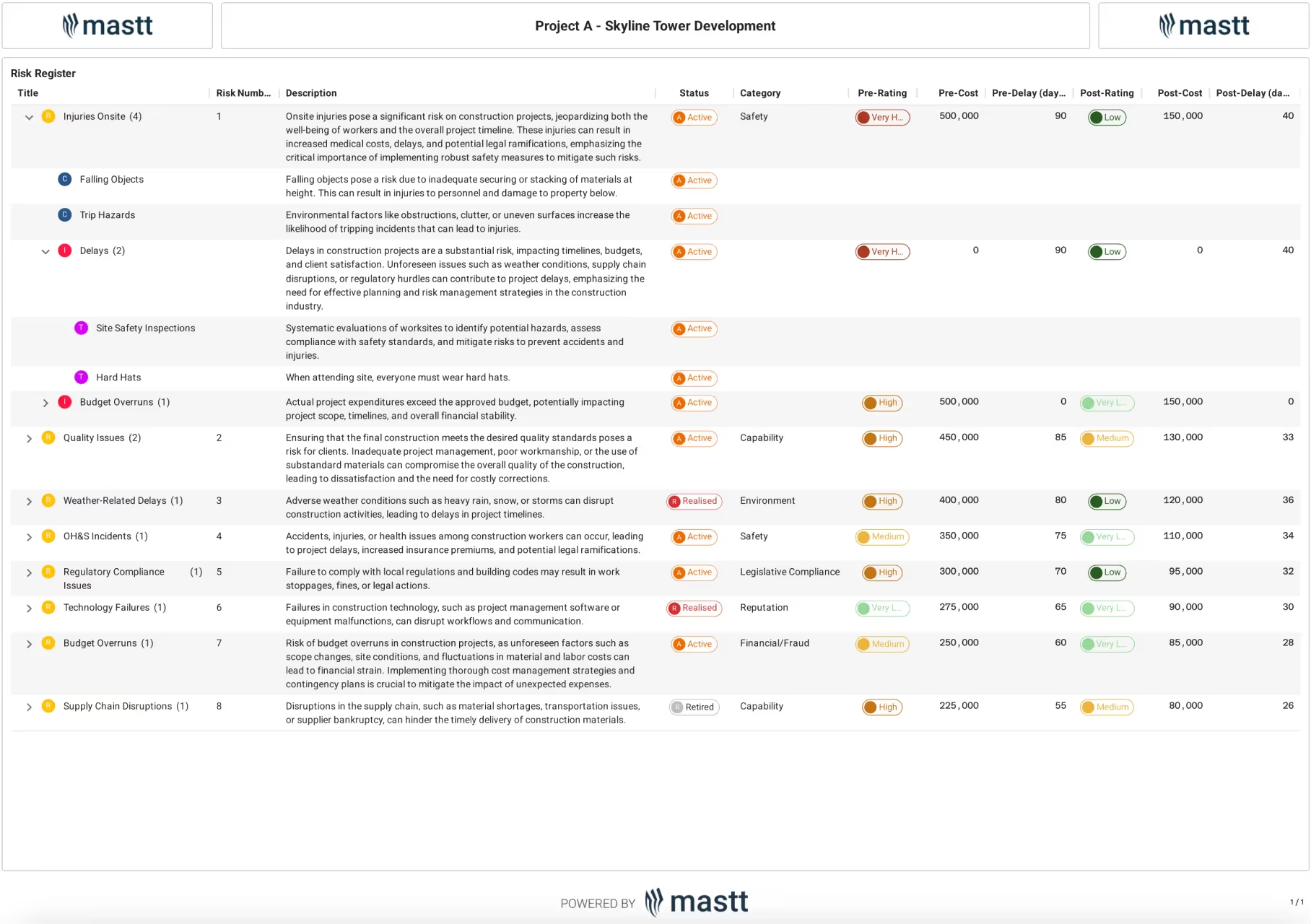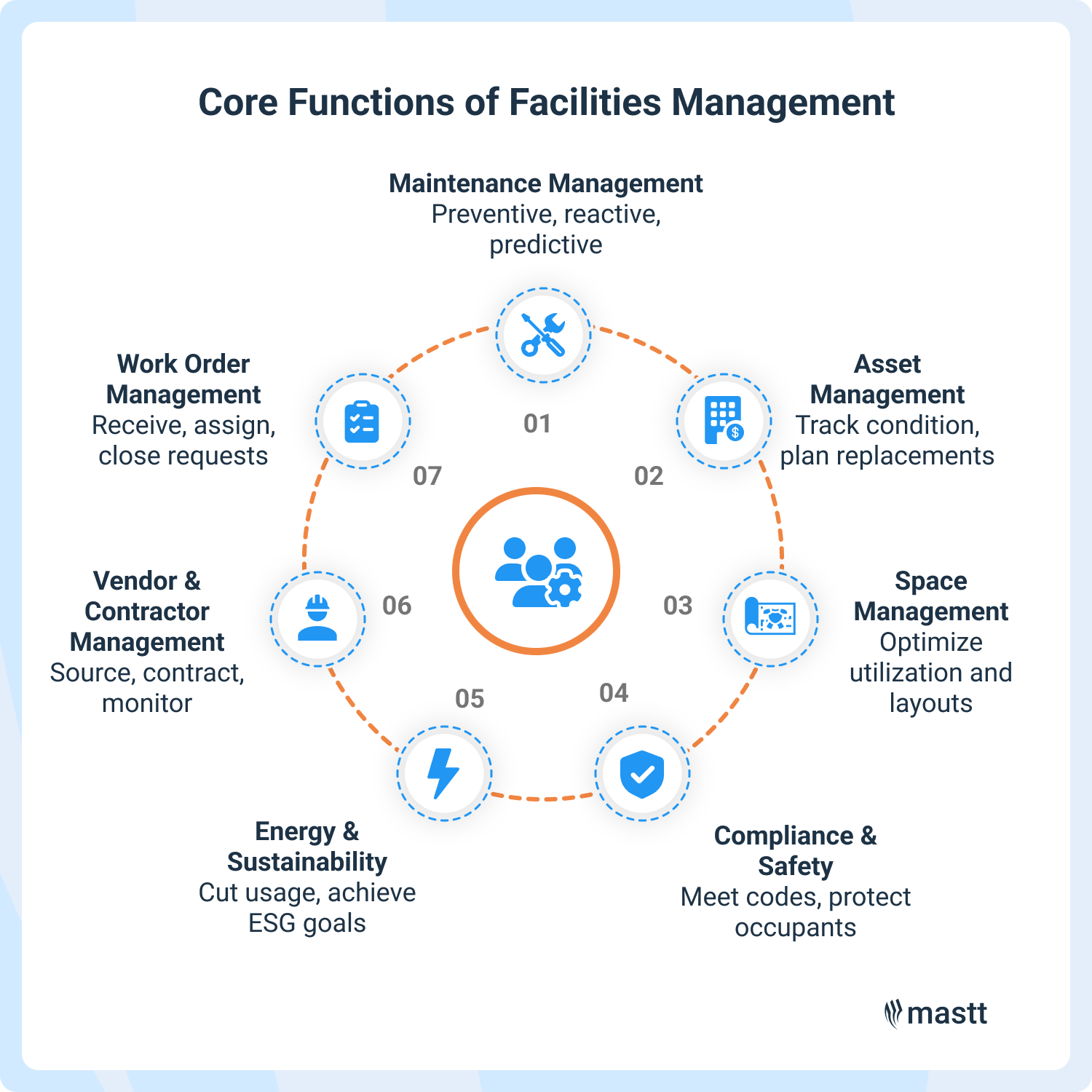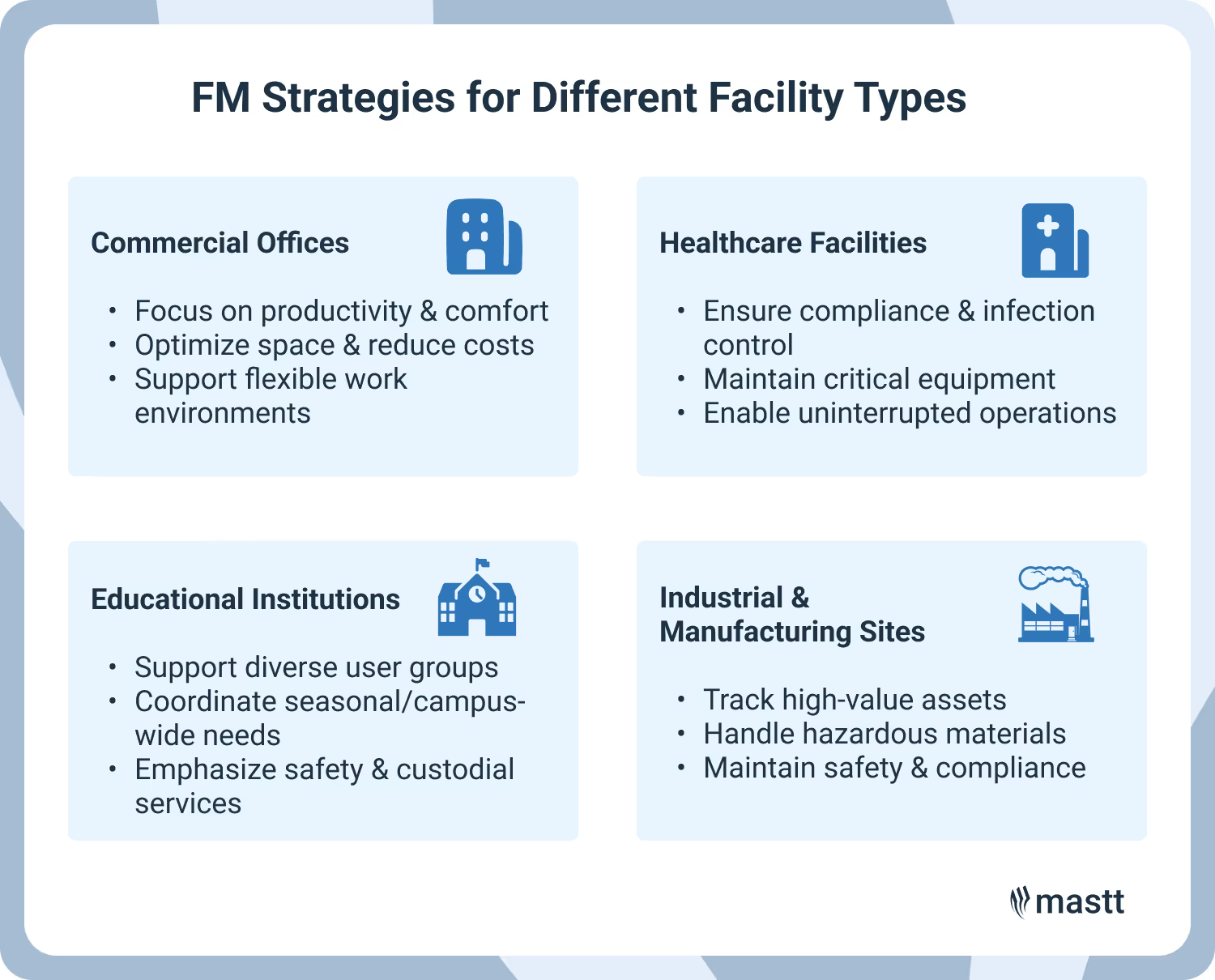Facilities management keeps buildings safe and efficient. Learn FM basics, services, and best practices to improve building operations and cut costs.

Use this FREE Risk Register Template to identify, assess, and treat risks before they escalate. Reduce delays, track cost impacts, and stay compliant using a proven risk format.

Facilities management keeps buildings safe, efficient, and aligned with operational goals after construction is complete. It ensures that systems, spaces, and services continue to perform as intended throughout the building’s lifecycle.
This guide explains what facilities management is and why it plays a critical role in asset performance. It also covers FM responsibilities, types of facility management services, digital tools, and emerging trends in modern building operations.
Facilities management (FM) coordinates services that keep buildings functional, safe, and efficient throughout their lifecycle. It includes facility maintenance, repairs, space management, and energy management to ensure the built environment supports organizational productivity and user needs.
The International Facility Management Association (IFMA) defines FM as a multidisciplinary profession focused on maintaining functionality through integrated systems. Facilities managers use data-driven approaches for risk management, improving sustainability, controlling costs, and supporting continuous business operations.
Facilities management services are grouped into three main categories: hard services, soft services, and strategic services. Each type addresses a different aspect of facility operation, from building systems to occupant experience and long-term planning. The table below explains what each category involves.
Facilities management services can be delivered internally by the facilities management department, outsourced, or through hybrid models. Organizations often use hybrid approaches to leverage external expertise while maintaining control over key operations.
Facilities management is important because it directly impacts how well an organization functions day-to-day. The practice supports public safety, employee productivity, and efficiency of the built environment while aligning with business goals.
The benefits below show why FM is a strategic priority, not just an operational task:
By investing in facilities management, organizations gain more control over their costs, risks, and workplace outcomes. It’s a key enabler of long-term resilience and growth.
Facilities management includes technical, strategic, and operational duties that keep facilities running effectively. These functions begin at handover, when responsibility shifts from construction to building operations. Below are the main functions carried out by FM teams.
Maintenance management keeps building systems running reliably through preventive, reactive, and predictive approaches. Preventive maintenance involves scheduled inspections and building maintenance tasks such as HVAC servicing. Predictive maintenance uses sensors and data analytics to identify potential failures before they occur.
Asset management tracks the condition of physical assets and predicts replacement needs through comprehensive records. Regular condition assessments evaluate asset performance and remaining useful life. Replacement forecasting helps facility managers plan capital expenditures and ensures resources for critical replacements.
Space management optimizes workplace utilization through strategic planning and occupancy monitoring. It analyzes how employees use spaces and identifies opportunities to enhance efficiency. This function supports hybrid workplace models through workplace planning and coordination.
Compliance and safety management ensure facilities meet regulatory requirements, including building codes and ISO 41001 standards. Regular inspections identify potential issues before they escalate. Fire safety systems require specialized maintenance protocols and emergency information programs.
Energy and sustainability management reduces environmental impact while controlling utility costs. Building management systems enable automated controls that optimize operational efficiency. Green building certifications require systematic documentation, demonstrating commitment to sustainability.
Vendor management involves selecting qualified service providers and negotiating performance-based contracts. Procurement processes establish contractor networks through competitive bidding and reference checks. Performance monitoring ensures vendors meet service agreements and quality standards.
Work order systems coordinate service requests and track maintenance requests across facilities. Employees submit work requests via online portals, and automated workflows route tasks to technicians. Managers monitor work order completion times and maintenance costs.

The facility manager plays the central role in overseeing building operations and aligning services with business goals. However, effective facility management depends on a team of professionals, each with specialized skills.
Key positions within facilities management departments typically include:
These roles increasingly intersect as facilities become digitized. Effective facilities management requires cross-functional collaboration to meet evolving operational needs.
Facilities management must adapt to the unique needs of different asset types. Each facility presents distinct operational demands, compliance requirements, and employee expectations.
Below are specific facility management approaches tailored to the needs of common facility types:
Facility-specific FM strategies drive greater value by addressing precise risks and functions of each environment. This targeted approach enhances service delivery, improves compliance, and enables data-driven decisions.

Technology helps facilities managers improve efficiency, reduce maintenance costs, and make smarter decisions. Tools range from automated maintenance management systems to real-time performance monitoring platforms.
Facilities management technologies typically fall into three core categories based on function and benefit.
As facility management evolves, integrated platforms become more valuable than standalone tools. Unified systems reduce duplication, delays, and data gaps. Platforms like Mastt centralize project data, reporting, and analytics to help managers make faster, smarter decisions.
Facilities management often breaks down when common mistakes go unaddressed. These errors can lead to higher costs, safety risks, and reduced building performance.
Here are common mistakes in facilities management and how to resolve them effectively:
1. Overreliance on Reactive Maintenance: Waiting for breakdowns leads to costly repairs and unplanned downtime.
✅ Solution: Establish preventive and predictive maintenance programs with routine checks and sensor-based alerts.
2. Neglecting Asset Management: Untracked physical assets can fail without warning, disrupting operations and budgets.
✅ Solution: Use digital tools to forecast replacements and plan capital expenses in advance.
3. Inefficient Space Utilization: Poorly used space wastes money and hurts occupant productivity.
✅ Solution: Monitor space usage patterns and redesign layouts to align with occupancy needs.
4. Lack of Clear KPIs: Without facility management metrics, performance goes unmeasured and inefficiencies stay hidden.
✅ Solution: Track key indicators like system uptime, maintenance requests, and energy use.
5. Insufficient Staff Professional Development: Skill gaps reduce service quality and increase safety risks.
✅ Solution: Provide ongoing professional development, certifications, and cross-skilling opportunities.
6. Falling Behind on Compliance: Missed inspections or outdated documentation can lead to fines or shutdowns.
✅ Solution: Automate compliance tracking and schedule regular internal reviews and updates.
7. Poor Emergency Preparedness: Unclear emergency information procedures delay response and increase risks during crises.
✅ Solution: Create response plans, train employees, and run drills to ensure readiness.
8. Disconnected Systems and Tools: Siloed data makes reporting and planning more difficult.
✅ Solution: Adopt integrated facility management platforms that bring together maintenance, space, and asset management.
9. Short-Term Cost Cutting: Skipping maintenance or delaying upgrades may save now, but cost more later.
✅ Solution: Focus on lifecycle value using total cost of ownership models to guide investment.
Mastt gives facilities management teams real-time data, oversight, and structure to prevent problems before they escalate. This shifts teams from reacting to issues toward proactively creating value and improving long-term building performance.
Four key trends are reshaping how facility management teams plan, operate, and deliver value. These include technology integration, sustainability, workplace change, and resilience planning.
Below are the key trends shaping the future of facilities management:
AI helps predict failures, optimize energy use, and reduce manual tasks through automation and machine learning. Teams adopting AI and flexible infrastructure will lead in safety, sustainability, and long-term building performance.
Facilities management keeps buildings efficient, resilient, and ready for future needs. Facility managers combine strategy with real-time data to guide decisions. This proactive approach strengthens asset performance, enhances user experience, and supports long-term financial success.

Cut the stress of showing up unprepared
Start for FreeTrusted by the bold, the brave, and the brilliant to deliver the future